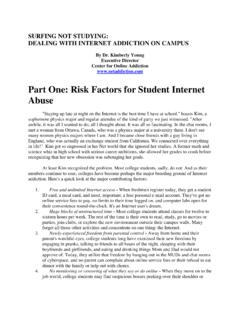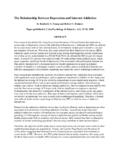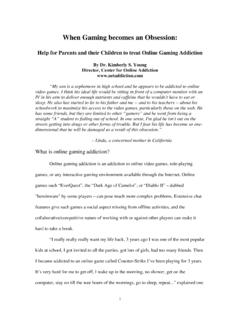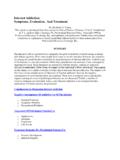Transcription of INTERNET ADDICTION: THE EMERGENCE OF A NEW …
1 INTERNET addiction : THE EMERGENCE OF A NEW CLINICAL DISORDER Kimberly S. Young University of Pittsburgh at Bradford Published in CyberPsychology and Behavior, Vol. 1 No. 3., pages 237-244 Paper presented at the 104th annual meeting of the American Psychological Association, Toronto, Canada, August 15, 1996. Anecdotal reports indicated that some on-line users were becoming addicted to the INTERNET in much that same way that others became addicted to drugs or alcohol which resulted in academic, social, and occupational impairment. However, research among sociologists, psychologists, or psychiatrists has not formally identified addictive use of the INTERNET as a problematic behavior. This study investigated the existence of INTERNET addiction and the extent of problems caused by such potential misuse. This study utilized an adapted version of the criteria for pathological gambling defined by the DSM-IV (APA, 1994). On the basis of this criteria, case studies of 396 dependent INTERNET users (Dependents) and a control group of 100 non-dependent INTERNET users (Non-Dependents) were classified.
2 Qualitative analyses suggests significant behavioral and functional usage differences between the two groups. Clinical and social implications of pathological INTERNET use and future directions for research are discussed. INTERNET addiction : The EMERGENCE Of A New Clinical Disorder Methodology Subjects Materials Procedures Results Demographics Usage Differences Length Of Time Using INTERNET Hours Per Week Applications Used Extent Of Problems Discussion References INTERNET addiction : THE EMERGENCE OF A NEW CLINICAL DISORDER Recent reports indicated that some on-line users were becoming addicted to the INTERNET in much the same way that others became addicted to drugs, alcohol, or gambling, which resulted in academic failure (Brady, 1996; Murphey, 1996); reduced work performance (Robert Half International, 1996), and even marital discord and separation (Quittner, 1997). Clinical research on behavioral addictions has focused on compulsive gambling (Mobilia, 1993), overeating (Lesieur & Blume, 1993), and compulsive sexual behavior (Goodman, 1993).
3 Similar addiction models have been applied to technological overuse (Griffiths, 1996), computer dependency (Shotton, 1991), excessive television viewing (Kubey & Csikszentmihalyi, 1990; McIlwraith et al., 1991), and obsessive video game playing (Keepers, 1991). However, the concept of addictive INTERNET use has not been empirically researched. Therefore, the purpose of this exploratory study was to investigate if INTERNET usage could be considered addictive and to identify the extent of problems created by such misuse. With the popularity and wide-spread promotion of the INTERNET , this study first sought to determine a set of criteria which would define addictive from normal INTERNET usage. If a workable set of criteria could be effective in diagnosis, then such criteria could be used in clinical treatment settings and facilitate future research on addictive INTERNET use. However, proper diagnosis is often complicated by the fact that the term addiction is not listed in the Diagnostic and Statistical Manual of Mental Disorders - Fourth Edition (DSM-IV; American Psychiatric Association, 1994).
4 Of all the diagnoses referenced in the DSM-IV, Pathological Gambling was viewed as most akin to the pathological nature of INTERNET use. By using Pathological Gambling as a model, INTERNET addiction can be defined as an impulse-control disorder which does not involve an intoxicant. Therefore, this study developed a brief eight-item questionnaire referred to as a Diagnostic Questionnaire (DQ) which modified criteria for pathological gambling to provide a screening instrument for addictive INTERNET use: 1. Do you feel preoccupied with the INTERNET (think about previous on-line activity or anticipate next on-line session)? 2. Do you feel the need to use the INTERNET with increasing amounts of time in order to achieve satisfaction? 3. Have you repeatedly made unsuccessful efforts to control, cut back, or stop INTERNET use? 4. Do you feel restless, moody, depressed, or irritable when attempting to cut down or stop INTERNET use? 5. Do you stay on-line longer than originally intended?
5 6. Have you jeopardized or risked the loss of significant relationship, job, educational or career opportunity because of the INTERNET ? 7. Have you lied to family members, therapist, or others to conceal the extent of involvement with the INTERNET ? 8. Do you use the INTERNET as a way of escaping from problems or of relieving a dysphoric mood ( , feelings of helplessness, guilt, anxiety, depression)? Respondents who answered "yes" to five or more of the criteria were classified as addicted INTERNET users (Dependents) and the remainder were classified as normal INTERNET users (Non-Dependents) for the purposes of this study. The cut off score of "five" was consistent with the number of criteria used for Pathological Gambling. Additionally, there are presently ten criteria for Pathological Gambling, although two were not used for this adaptation as they were viewed non-applicable to INTERNET usage. Therefore, meeting five of eight rather than ten criteria was hypothesized to be a slightly more rigorous cut off score to differentiate normal from addictive INTERNET use.
6 It should be noted that while this scale provides a workable measure of INTERNET addiction , further study is needed to determine its construct validity and clinical utility. It should also be noted that the term INTERNET is used to denote all types of on-line activity. [Return to Index] METHODOLOGY Subjects Participants were volunteers who respondent to: (a) nationally and internationally dispersed newspaper advertisements, (b) flyers posted among local college campuses, (c) postings on electronic support groups geared towards INTERNET addiction ( , the INTERNET addiction Support Group, the Webaholics Support Group), and (d) those who searched for keywords " INTERNET addiction " on popular Web search engines ( , Yahoo). Materials An exploratory survey consisting of both open-ended and closed-ended questions was constructed for this study that could be administered by telephone interview or electronic collection. The survey administered a Diagnostic Questionnaire (DQ) containing the eight-item classification list.
7 Subjects were then asked such questions as : (a) how long they have used the INTERNET , (b) how many hours per week they estimated spending on-line, (c) what types of applications they most utilized, (d) what made these particular applications attractive, (e) what problems, if any, did their INTERNET use cause in their lives, and (f) to rate any noted problems in terms of mild, moderate, or severe impairment. Lastly, demographic information from each subject such as age, gender, highest educational level achieved, and vocational background were also Procedures Telephone respondents were administered the survey verbally at an arranged interview time. The survey was replicated electronically and existed as a World-Wide-Web (WWW) page implemented on a UNIX-based server which captured the answers into a text file. Electronic answers were sent in a text file directly to the principal investigator s electronic m ailbox for analysis . Respondents who answered "yes" to five or more of the criteria were classified as addicted INTERNET users for inclusion in this study.
8 A total of 605 surveys in a three month period were collected with 596 valid responses that were classified from the DQ as 396 Dependents and 100 Non-Dependents. Approximately 55% of the respondents replied via electronic survey method and 45% via telephone survey method. The qualitative data gathered were then subjected to content analysis to identify the range of characteristics, behaviors and attitudes found. [Return to Index] RESULTS Demographics The sample of Dependents included 157 males and 239 females. Mean ages were 29 for males, and 43 for females. Mean educational background was years. Vocational background was classified as 42% none ( , homemaker, disabled, retired, students), 11% blue-collar employment, 39% non-tech white collar employment, and 8% high-tech white collar employment. The sample of Non-Dependents included 64 males and 36 females. Mean ages were 25 for males, and 28 for females. Mean educational background was 14 years. Usage Differences The following will outline the differences between the two groups, with an emphasis on the Dependents to observe attitudes, behaviors, and characteristics unique to this population of users.
9 Length of Time using INTERNET The length of time using the INTERNET differed substantially between Dependents and Non-Dependent. Among Dependents, 17% had been online for more than one year, 58% had only been on-line between six months to one year, 17% said between three to six months, and 8% said less than three months. Among Non-Dependents, 71% had been online for more than one year, 5% had been online between six months to one year, 12% between three to six months, and 12% for less than three months. A total of 83% of Dependents had been online for less than one full year w hich m ight suggest that addiction to the INTERNET happens rather quickly from one s first introduction to the service and products available online. In many cases, Dependents had been computer illiterate and described how initially they felt intimidated by using such information technology. However, they felt a sense of competency and exhilaration as their technical mastery and navigational ability improved rapidly.
10 Hours Per Week In order to ascertain how much time respondents spent on-line, they were asked to provide a best estimate of the number of hours per week they currently used the INTERNET . It is important to note that estimates were based upon the number of hours spent "surfing the INTERNET " for pleasure or personal interest ( , personal e-mail, scanning news groups, playing interactive games) rather than academic or employment related purposes. Dependents spent a M = , SD = hours per week compared to Non-Dependents who spent M= , SD = hours per week. These estimates show that Dependents spent nearly eight times the number of hours per week as that of Non-Dependents in using the INTERNET . Dependents gradually developed a daily INTERNET habit of up to ten times their initial use as their familiarity with the INTERNET increased. This may be likened tolerance levels which develop among alcoholics who gradually increase their consumption of alcohol in order to achieve the desired effect.




